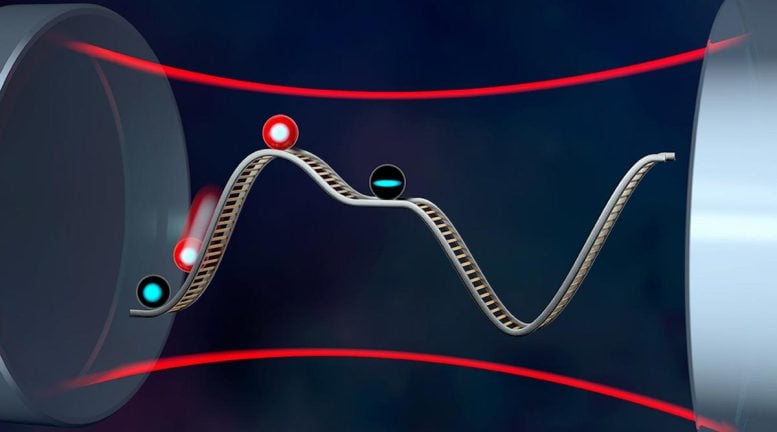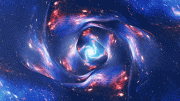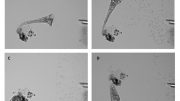
Multilevel atoms on a superradiance potential “rollercoaster” inside an optical cavity. The system can be tuned to generate squeezing in a dark state where it will be immune to superradiance. Credit
Steven Burrows/Rey Group
Physicists are pushing the limits of atomic clock accuracy by using spin-squeezed states, achieving groundbreaking control over quantum noise and entanglement, leading to potential leaps in quantum metrology.
While atomic clocks are already the most precise timekeeping devices in the universe, physicists are working hard to improve their accuracy even further. One way is by leveraging spin-squeezed states in clock atoms. Spin-squeezed states are entangled states in which particles in the system conspire to cancel their intrinsic quantum noise. These states, therefore, offer great opportunities for quantum-enhanced metrology since they allow for more precise measurements. Yet, spin-squeezed states in the desired optical transitions with little outside noise have been hard to prepare and maintain.
One particular way to generate a spin-squeezed state, or squeezing, is by placing the clock atoms into an optical cavity, a set of mirrors where light can bounce back and forth many times. In the cavity, atoms can synchronize their photon emissions and emit a burst of light far brighter than from any one atom alone, a phenomenon referred to as superradiance. Depending on how superradiance is used, it can lead to entanglement, or alternatively, it can instead disrupt the desired quantum state.
In a prior study, done in a collaboration between JILA and NIST Fellows, Ana Maria Rey and James Thompson, the researchers discovered that multilevel atoms (with more than two internal energy states) offer unique opportunities to harness superradiant emission by instead inducing the atoms to cancel each other’s emissions and remain dark.
Now, reported in a pair of new papers published in Physical Review Letters and Physical Review A, Rey and her team discovered a method for how to not only create dark states in a cavity, but more importantly, make these states spin squeezed. Their findings could open remarkable opportunities for generating entangled clocks, which could push the frontier of quantum metrology in a fascinating way.
Rolling Into a Dark State on a Superradiant Roller Coaster
For several years, Rey and her team have studied the possibility of harnessing superradiance by forming dark states inside a cavity. Because dark states are unique configurations where the usual paths of light emission interfere destructively, these states do not emit light. Rey and her team have shown that dark states could be realized when atoms prepared in certain initial states were placed inside a cavity. Prepared in this way, the quantum states could remain impervious to the effects of superradiance or light emission into the cavity. The atoms could still emit light outside the cavity, but at a pace that is much slower than superradiance.
Former JILA postdoctoral researcher Asier Piñeiro Orioli, the lead researcher in the prior study with Thompson, and also a contributor to the two recently published studies, found a simple way to understand the emergence of a dark state in a cavity in terms of what they called a superradiant potential.
Rey elaborates: “We can imagine the superradiant potential as a roller coaster where atoms ride. As they fall down the hill, they emit light collectively, but they can get stuck when they reach a valley. At the valleys, the atoms form the dark states and stop emitting light into the cavity.”
In their previous work with Thompson, the JILA researchers found that the dark states must be at least a little bit entangled.
“The question we aimed to address in the two new works is whether they can be both dark and highly entangled,” explains first author Bhuvanesh Sundar, a former JILA postdoctoral researcher. “The exciting part is that we not only found that the answer is yes, but that these types of squeezed states are rather straightforward to prepare.”
Creating Highly Entangled Dark States
In the new studies, the researchers figured out two possible ways to prepare the atoms in highly entangled spin-squeezed states. One way was by shining the atoms with a laser to energize them above their ground state and then placing them into special points on the superradiant potential, also known as saddle points. At the saddle points, the researchers let atoms relax in the cavity by switching off the laser, and interestingly, the atoms reshape their noise distribution and become highly squeezed.
“The saddle points are valleys where the potential has zero curvature and zero slope simultaneously,” Rey elaborates. “These are special points because atoms are dark but on the verge of becoming unstable and therefore tend to reshape their noise distribution to becoming squeezed.”
The other proposed method involved the transfer of superradiant states into dark states. Here, the team also found other special points where the atoms are close to special “bright” points—not in a valley of the roller coaster, but at points with zero curvature—where the interplay between superradiance and an external laser generates spin-squeezing.
“The neat thing is that the spin squeezing generated at these bright points can then be transferred into a dark state where, after appropriate alignment, we can turn off the laser and preserve the squeezing,” Sundar adds.
This transfer works by first driving the atoms into a valley of the superradiant potential and then using lasers with appropriate polarizations (or directions of light oscillations) to coherently align the squeezed directions, making the squeezed states immune to superradiance.
The transfer of squeezed states into dark states not only preserved the reduced noise characteristics of the squeezed states, but also ensured their survival in the absence of being driven by an external laser, a crucial factor for practical applications in quantum metrology.
While the study published in Physical Review Letters used only one polarization of the laser light to induce spin squeezing, generating two squeezed modes, the Physical Review A paper took this simulation further by using both polarizations of laser light, resulting in four spin-squeezed modes (two modes for each polarization).
“In these two papers, we considered multilevel atoms with many internal levels,” elaborates Piñeiro Orioli, “and having many internal levels is harder to simulate than having two levels, which is often studied in the literature. So, we developed a set of tools to solve these multilevel systems. We worked out a formula to calculate entanglement generated from the initial state.”
An Improvement to Quantum Metrology
The findings of these studies can have far-reaching implications for atomic clocks. By overcoming the limitations of superradiance via the generation of dark entangled states, physicists either store the entangled states using the atoms as a memory (allowing for the retrieval of information from these states) or inject the entangled state into a clock or interferometer sequence for quantum-enhanced measurements.
References:
“Squeezing Multilevel Atoms in Dark States via Cavity Superradiance” by Bhuvanesh Sundar, Diego Barberena, Ana Maria Rey and Asier Piñeiro Orioli, 17 January 2024, Physical Review Letters.
DOI: 10.1103/PhysRevLett.132.033601
“Driven-dissipative four-mode squeezing of multilevel atoms in an optical cavity” by Bhuvanesh Sundar, Diego Barberena, Ana Maria Rey and Asier Piñeiro Orioli, 17 January 2024, Physical Review A.
DOI: 10.1103/PhysRevA.109.013713
This research was supported by the U.S. Department of Energy, Office of Science, National Quantum Information Science Research Centers Quantum Systems Accelerator, and the National Institute of Standards and Technology (NIST).









Researchers have become accustomed to boasting that their research has been published in a so-called academic journal. However, the so-called academic journals are actually a variant of pseudoscientific journals, and this vicious cycle has caused unprecedented harm to scientific development.
The universe does not do algebra, formula or fraction. The universe is geometrythe,and is the superposition, deflection, and twisting of geometric shapes.
Today, we have already entered the era of the internet. With the help of artificial intelligence and big data, discussions on scientific knowledge have become open and transparent. However, a group of editors of so-called academic journals (such as Physical Review Letters, Nature, Science, etc.) are self-righteous and mystifying themselves. They only care about their own so-called sufficiently high priority rating, general significance, discipline, novelty, etc., and do not care about what science and pseudoscience are.
Science and pseudoscience are not determined by a publication, an organization or a person, nor by you or me, but by mathematics the final say. Physical models must be based on mathematics or mathematical models in order to be scientific, convincing, and in accordance with natural laws.
The branch of geometry (mathematics) known as topology has become a cornerstone of modern physics. Topological vortex and antivortex are two bidirectional coupled continuous chaotic systems. They exhibit parity conservation, charge conjugation, and time reversal symmetry. The synchronization effect is extremely important in their interactions. The synchronization effect of the superposition, deflection, and twisting of multiple or countless topological vortices will make spacetime motion more complex. To understand this complex world, physics should respect the authenticity of topological vortex in low dimensional spacetime, rather than simply relying on a few formulas, numbers, or imagined particles.
Spin is a natural property of topological vortices. Spin is synchronized with energy, spin is synchronized with gravitation, spin is synchronized with time, spin is synchronized with evolution. The perpetually swirling topological vortices defy traditional physics’ expectations. One physical properties of topological vortices is them to spontaneously begin to change periodically in time, even though the system does not experience corresponding periodic interference. Therefore, in the interaction of topological vortices, time is both absolute and relative,and physics often requires treating space and time at the same level.
Low-dimensional spacetime matter is the foundation of high-dimensional spacetime matter. Low-dimensional spacetime matter (such as topological vortex) can form new material structures and derive more complex physical properties via interactions and self-organization. It is extremely wrong and irresponsible to imagine low dimensional spacetime matter using high-dimensional spacetime matter,such as a cat in quantum mechanics.
Science must follow mathematical rules. For example, the Standard Model (SM) is considered to be one of the most significant achievements of physics in the 20th century. However, the magnetic moment of μ particle is larger than expected, revealed by a g-2 experiment at Fermilab, suggests that the established theory (such as SM) of fundamental particles is incomplete. Furthermore, the SM omitting gravitation, it not involved the time problem and when the particle movement starts. Mathematics is the foundation of science. Physics must respect the scientific nature of mathematics and mathematical models. The SM must be based on mathematical models in order to be scientific, convincing, and in line with natural laws.
I hope researchers are not fooled by the pseudoscientific theories of the Physical Review Letters (PRL), and hope more people dare to stand up and fight against rampant pseudoscience.
The so-called academic journals (such as Physical Review Letters, Nature, Science, etc.) firmly believe that two high-dimensional spacetime objects (such as two sets of cobalt-60) rotating in opposite directions can be transformed into two objects that mirror each other, is a typical case of pseudoscience rampant.
If researchers are really interested in Science and Physics, you can browse https://zhuanlan.zhihu.com/p/643404671 and https://zhuanlan.zhihu.com/p/595280873.